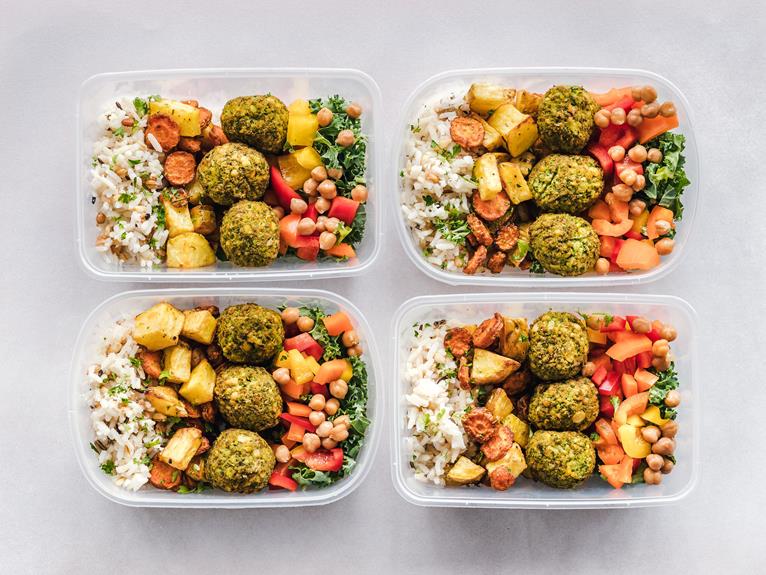With the rising cost of groceries, many people are seeking ways to cut down on their food expenses without compromising on quality. Budget-friendly meal planning is a smart and effective way to achieve this goal.
By incorporating cost-effective ingredients, utilizing leftovers, and being strategic with your meal choices, you can stretch your food budget while still enjoying a wide variety of delicious meals.
Meal Planning on a Budget
When it comes to meal planning on a budget, it’s important to be smart with your choices and find affordable grocery shopping options. Here are some tips to help you save money while still enjoying delicious and nutritious meals.
Start by making a list before you go to the grocery store. This will help you stay focused and avoid impulse purchases. Plan your meals for the week and create a shopping list based on those recipes. Stick to your list and avoid buying unnecessary items.
Take advantage of sales and discounts. Check out the weekly flyers and plan your meals around the items that are on sale. Buying in bulk when possible and freezing extra ingredients for future use can also save you money in the long run.
Consider buying seasonal produce. Seasonal fruits and vegetables are often cheaper and fresher. Incorporate these ingredients into your meal plan for a cost-effective and nutritious option.
Cooking in bulk is another money-saving strategy. Prepare larger portions and freeze the leftovers for future meals. This not only saves you time but also allows you to utilize your ingredients more efficiently.

Quick and Easy Meal Prep
When it comes to meal prep, you’ll want to find quick and easy methods to make your weeknight dinners a breeze. Here are some time-saving tips and quick meal ideas to help you streamline your meal prep process:
- Plan your meals in advance: Take a few minutes each week to plan out your meals. This will help you avoid last-minute decisions and save time at the grocery store.
- Prep ingredients in bulk: Spend some time on the weekends chopping vegetables, marinating meat, or cooking grains in bulk. This way, you’ll have prepped ingredients ready to go when it’s time to cook during the week.
- Use sheet pan and one-pot meals: Opt for recipes that can be cooked all in one pan or pot. These meals not only save time on clean-up, but they also minimize the amount of active cooking time required.
Healthy and Affordable Recipes
Looking for healthy and affordable recipes? Here are some nutritious and budget-friendly meal ideas that will satisfy your taste buds without breaking the bank. Eating well doesn’t have to be expensive.
With a little planning and creativity, you can enjoy delicious and nutritious meals without spending a fortune.
A great budget-friendly option is to make a big batch of vegetable soup. You can use inexpensive ingredients like carrots, celery, onions, and canned tomatoes. Add some herbs and spices for flavor, and you have a hearty and nutritious meal that will last for days.
Another affordable and nutritious idea is stir-fried vegetables with brown rice. You can use whatever vegetables are on sale or in season, such as broccoli, bell peppers, and mushrooms. Pair it with cooked brown rice for a balanced and satisfying meal.
If you’re looking for a protein-packed option, try making a lentil curry. Lentils aren’t only affordable but also a great source of protein and fiber. Cook them with onions, garlic, and spices, and serve it over rice or with some naan bread. It’s a budget-friendly meal that will keep you full and satisfied.
With these recipes, you can enjoy delicious and nutritious meals without breaking the bank. So go ahead and give them a try!
Using Pantry Staples for Meal Planning
To save money and get creative with your recipes, let’s explore using pantry staples for meal planning. Here are three ways to make the most of your pantry staples:
- Enhance flavor: Make your dishes more delicious by using spices and seasonings from your pantry. Try combinations like garlic powder, cumin, and paprika for a Mexican-inspired dish, or oregano, basil, and thyme for an Italian twist. Be adventurous and experiment with different spices to create unique flavors.
- Add sauces and condiments: Transform simple meals into flavorful dishes by using pantry staples like soy sauce, Worcestershire sauce, or tomato paste. These ingredients can add depth and richness to your cooking. Mix them with other pantry items like honey, vinegar, or mustard to create homemade marinades and dressings.
- Rice and beans versatility: Rice and beans are affordable, nutritious, and can be the base for many meals. Use them as fillings for burritos or tacos, add them to soups and stews, or enjoy them as a side dish. Flavor them with spices, herbs, and vegetables to create a satisfying meal.
Saving Money With Batch Cooking
Batch cooking is a fantastic way to save money and simplify meal planning. Even if you live in a small household, you can still benefit from batch cooking. It allows you to prepare multiple meals at once and freeze the leftovers for future use. This not only saves you time and effort in the kitchen, but it also helps you resist the temptation of ordering takeout on busy nights.
When batch cooking for a small household, it’s important to choose freezer-friendly meal ideas. Look for recipes that can be easily divided into individual portions and reheated when needed.
Casseroles, soups, stews, and pasta dishes are all excellent options. You can also prepare ingredients in advance, such as cooking a large batch of grains or chopping vegetables, and store them in the freezer for quick and convenient use.
By batch cooking, you can simplify your meal planning and save money by avoiding the need to order takeout. It’s a practical solution for small households, allowing you to prepare multiple meals at once and freeze the extras for later use. Freezer-friendly meal ideas such as casseroles, soups, stews, and pasta dishes are perfect for batch cooking. Additionally, you can save time by prepping ingredients in advance and storing them in the freezer.
Planning Meals Around Sales and Discounts
When planning meals around sales and discounts, take advantage of the savings by incorporating discounted ingredients into your menu. By following these meal-planning tips and grocery-shopping strategies, you can save money while still enjoying delicious and nutritious meals.
- Plan your meals around the weekly sales flyers: Before creating your menu for the week, check out the sales flyers from your local grocery stores. Look for discounted items like meat, poultry, or vegetables and plan your meals accordingly.
- Stock up on pantry staples when they’re on sale: Pantry staples like rice, pasta, canned goods, and spices often go on sale. Take advantage of these discounts by buying in bulk and storing them for future use. This way, you’ll always have affordable ingredients on hand to create a variety of meals.
- Don’t be afraid to try new recipes with discounted ingredients: When you come across a great deal on an ingredient you’ve never tried before, use it as an opportunity to explore new recipes. You might discover a new favorite dish while saving money at the same time.
Incorporating Leftovers Into Meal Plans
Make the most of your leftovers by incorporating them into your meal plans for the week ahead. This not only saves you money, but also helps reduce food waste. Instead of letting those leftovers sit in the back of your fridge, get creative and use them in new dishes that your whole family will love.
One way to be creative with leftovers is by using them as ingredients in new recipes. For example, you can shred leftover roasted chicken and use it in a hearty chicken noodle soup or add it to a salad for extra protein.
Leftover vegetables can be used in stir-fries, frittatas, or even as toppings for homemade pizzas. The possibilities are endless when it comes to repurposing leftovers.
Another option is to plan your meals around the leftovers you have. Take a look at what you have on hand and come up with meal ideas that incorporate those leftovers. If you have leftover grilled steak, for instance, you can use it in tacos, sandwiches, or even as a topping for a loaded baked potato.
Budget-Friendly Vegetarian Meal Ideas
Looking to save money while enjoying delicious meals? Try adding budget-friendly vegetarian options to your meal plans. Vegetarian meal prep is a great way to save money and still have tasty and nutritious meals.
Here are three affordable plant-based recipes to get you started:
- Lentil and vegetable stir-fry: Lentils are a budget-friendly source of protein and can be paired with various vegetables for a filling and nutritious meal. Sauté your choice of vegetables like bell peppers, carrots, and broccoli. Then, add cooked lentils and stir-fry sauce. Serve over rice or noodles for a satisfying meal.
- Chickpea curry: Canned chickpeas are an inexpensive pantry staple that can be transformed into a delicious curry. Sauté onions, garlic, and spices such as cumin, turmeric, and coriander. Add canned tomatoes, coconut milk, and chickpeas. Simmer until the flavors meld together and serve with rice or naan bread.
- Veggie-packed pasta: Pasta is a versatile and affordable ingredient that can be paired with a variety of vegetables. Sauté zucchini, mushrooms, and spinach in olive oil, then toss with cooked pasta and a sprinkle of grated cheese. This simple and budget-friendly meal can be prepared in no time.
Incorporating these budget-friendly vegetarian options into your meal plans can help you save money while still enjoying delicious and nutritious meals. Give them a try and see how tasty and affordable plant-based eating can be.
Meal Planning for Picky Eaters on a Budget
If you have picky eaters in your household and are on a budget, meal planning can help ensure that everyone is satisfied without overspending. Meal planning for picky eaters can be challenging, but with some creativity and affordable tips, you can make it work.
Involve your picky eaters in the meal-planning process. Ask for their input and let them choose some meals for the week. This gives them a sense of ownership and increases the likelihood that they’ll eat what’s prepared.
Next, focus on simple and familiar dishes. Picky eaters often prefer foods they’re already familiar with, so stick to their favorites while gradually adding new ingredients or flavors to expand their palate.
When shopping, try buying in bulk and taking advantage of sales and discounts. Planning your meals around what’s on sale can save money and ensure you get the best deals.
Lastly, consider incorporating meatless meals into your plan. Vegetarian dishes tend to be budget-friendly and can still be delicious and satisfying for picky eaters. Experiment with different proteins like beans, lentils, or tofu to provide variety and keep costs down.
Cooking With Inexpensive Protein Sources
If you want to cater to picky eaters without breaking the bank, consider cooking with inexpensive protein sources. Not only will this save you money, but it will also allow you to get creative in the kitchen.
Here are three ideas to help you get started:
- Beans and Legumes: Beans and legumes are a great source of protein and can be used in various dishes. You can make a hearty chili using kidney beans and black beans, or try a tasty lentil soup. You can even use mashed chickpeas as a base for veggie burgers or falafel.
- Eggs: Eggs aren’t only affordable but also incredibly versatile. You can enjoy them scrambled, poached, or boiled for a quick and easy protein-packed meal. Get creative and make omelets filled with vegetables or whip up a frittata using leftover ingredients from your fridge.
- Canned Tuna or Salmon: Canned tuna and salmon are excellent, budget-friendly sources of protein. Use them to make tuna or salmon salad sandwiches, mix them into pasta dishes, or add them to salads for an extra protein boost.
Utilizing Seasonal Produce in Meal Plans
Take advantage of the benefits of incorporating seasonal produce into your meal plans. Not only will you maximize flavor and freshness, but you’ll also stay within your budget. By using fresh ingredients that are in season, you can enjoy tastier and more nutritious meals.
When fruits and vegetables are in season, they’re at their peak of ripeness, resulting in better flavor and texture. Plus, they’re packed with essential vitamins, minerals, and antioxidants that are beneficial for your overall health.
Meal planning with fresh ingredients allows you to create diverse and delicious dishes while keeping your grocery bill in check. Plan your meals around the seasonal produce available at your local market or grocery store to ensure you’re getting the best quality at the best price. Buying seasonal produce supports local farmers and reduces the environmental impact of long-distance transportation.
To make the most of seasonal produce, it’s important to be aware of what’s in season during each time of the year. This way, you can plan your meals accordingly and take advantage of the abundance of fresh, flavorful ingredients.
Consider incorporating seasonal fruits and vegetables into your breakfast smoothies, salads, stir-fries, and main dishes. By doing so, you not only save money but also enhance the taste and nutritional value of your meals.
Creating Theme Nights for Variety and Savings
Looking to add some excitement and variety to your meals without breaking the bank? Creating theme nights is a great way to achieve just that. Not only will it save you money, but it will also bring a sense of adventure to your family dinners.
Let’s explore three ideas for theme nights that are perfect for a family on a tight budget:
- Taco Tuesdays: Spice up your Tuesdays with a fiesta of delicious and affordable tacos. You can mix things up by using different fillings like ground beef, chicken, or beans. Let everyone customize their tacos with toppings such as salsa, cheese, and guacamole. It’s a fun and easy way to bring some Mexican flair to your table without breaking the bank.
- Meatless Mondays: Going meatless once a week not only saves you money but also promotes a healthier lifestyle. Explore vegetarian recipes like lentil curry, vegetable stir-fry, or pasta primavera. These dishes aren’t only budget-friendly but also packed with nutrients. Plus, it’s a great opportunity to introduce your family to new flavors and expand their taste buds.
- Pizza Fridays: Who doesn’t love pizza? Instead of ordering expensive takeout, why not make your pizza at home? It’s a fun activity that the whole family can participate in. You can use store-bought pizza dough or make your own. Let everyone choose their favorite toppings, from classic Margherita to creative combinations. By making your pizza, you’ll save money and enjoy a delicious and satisfying meal.
Creating theme nights in your meal planning is a fantastic way to add variety and excitement while saving money. With these ideas, you can enjoy delicious meals without breaking the bank.
Meal Planning for a Family on a Tight Budget
If you want to save money while planning meals for your family on a tight budget, there are several strategies you can use. Here are some practical tips to help you plan your family meals on a tight budget:
- Plan your meals in advance: By planning your meals ahead of time, you can make a shopping list and avoid impulse purchases. This will help you stick to your budget and reduce food waste.
- Use ingredients you already have: Take inventory of what you already have in your pantry and fridge. Try to incorporate those ingredients into your meal plan to save money and reduce waste.
- Cook in batches and freeze leftovers: Cooking in larger quantities and freezing leftovers can save you time and money. You can use these leftovers for future meals, reducing the need to buy more ingredients.
- Incorporate meatless meals: Meat can be expensive, so try to incorporate meatless meals into your plan. Beans, lentils, and tofu are affordable sources of protein that can be used in a variety of dishes.
- Shop from your pantry first: Before heading to the grocery store, take a look at what you already have in your pantry. Try to use those ingredients in your meal plan before buying more.
- Buy in bulk to save money: Buying staple items in bulk can help you save money in the long run. Look for sales and discounts on items that you use frequently.
- Shop for seasonal produce: Seasonal produce is often cheaper and more flavorful. Plan your meals around what’s in season to save money and enjoy fresh ingredients.
- Compare prices and look for sales: Take the time to compare prices at different stores and look for sales and discounts. This can help you get the best deals on your grocery purchases.
- Use coupons and loyalty cards: Take advantage of coupons and loyalty cards to save money on your grocery purchases. Look for digital coupons and sign up for loyalty programs at your favorite stores.
By implementing these meal planning hacks and grocery shopping tips, you can save money while still providing your family with delicious and nutritious meals.
Tips for Reducing Food Waste While Meal Planning
To optimize your budget-friendly meal planning, let’s explore strategies for minimizing food waste. Reducing food waste not only saves money but also contributes to a more sustainable lifestyle. Here are three tips to help you on your journey:
- Plan your meals carefully: Before going to the grocery store, take a few minutes to plan your meals for the week. This will help you buy only what you need and avoid impulse purchases. You can also use leftovers from one meal as ingredients for another to make the most of your ingredients.
- Store your food properly: Make sure to store your food correctly to keep it fresh for longer. Use airtight containers to store fruits and vegetables, which will help them stay fresh. If you have excess ingredients or leftovers that you won’t be using right away, consider freezing them. This will prevent spoilage and allow you to use them in future meals.
- Get creative: Use your creativity to make use of ingredients that are close to their expiration date. For example, you can use overripe bananas in smoothies or banana bread. Leftover vegetables can be transformed into delicious soups or stir-fries. By thinking outside the box, you can make the most of what you have and minimize waste.
Conclusion
Meal planning on a budget doesn’t have to be dull or restrictive. With some creativity and resourcefulness, you can whip up delicious and affordable meals for yourself and your family.
Planning your meals on a budget isn’t only a way to take control of your finances but also a way to show love and care to your loved ones through nourishing food.











